Wal-Mart's Foreign Expansion: A Case Study Analysis
VerifiedAdded on 2019/09/16
|7
|2423
|297
Report
AI Summary
The assignment requires students to submit a report on the topic of Formatting and Layout. The report must be typed on A4 paper using Times New Roman or Arial font, with at least 2.5 centimeter space at each edge, double spaced and pages numbered. The report should be in Harvard referencing style and include a clear title, course, and name or ID number on the cover sheet. The student is expected to demonstrate their knowledge and understanding of the subject area by providing evidence of logical, analytical thinking, evaluation, and synthesis. The report should also provide practical application and deployment of models, methods, techniques, and theories in real-world situations. Finally, the report must demonstrate skills for professional practice such as effective communication, individual initiative, and collaborative working.
Contribute Materials
Your contribution can guide someone’s learning journey. Share your
documents today.
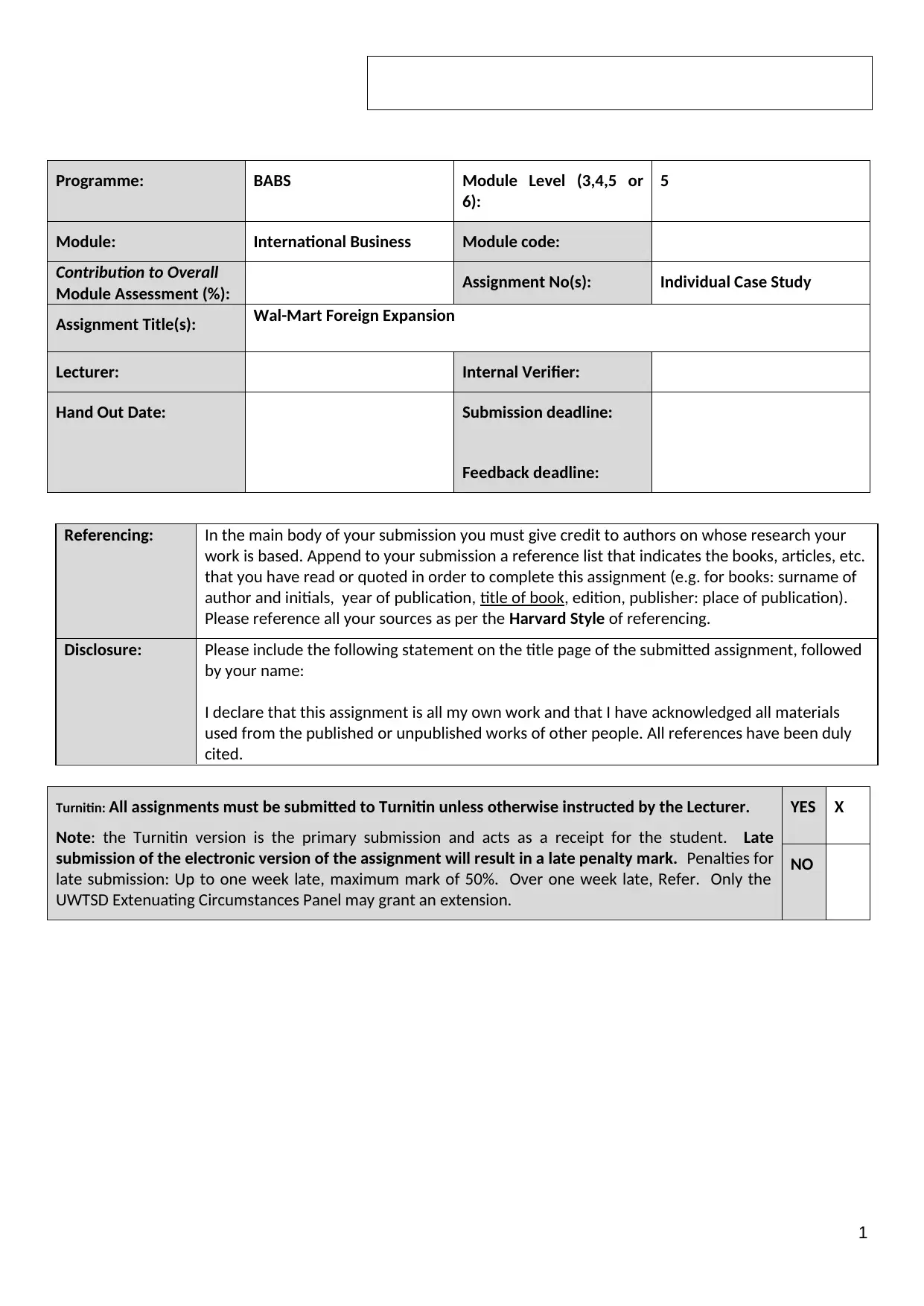
Programme: BABS Module Level (3,4,5 or
6):
5
Module: International Business Module code:
Contribution to Overall
Module Assessment (%): Assignment No(s): Individual Case Study
Assignment Title(s): Wal-Mart Foreign Expansion
Lecturer: Internal Verifier:
Hand Out Date: Submission deadline:
Feedback deadline:
Referencing: In the main body of your submission you must give credit to authors on whose research your
work is based. Append to your submission a reference list that indicates the books, articles, etc.
that you have read or quoted in order to complete this assignment (e.g. for books: surname of
author and initials, year of publication, title of book, edition, publisher: place of publication).
Please reference all your sources as per the Harvard Style of referencing.
Disclosure: Please include the following statement on the title page of the submitted assignment, followed
by your name:
I declare that this assignment is all my own work and that I have acknowledged all materials
used from the published or unpublished works of other people. All references have been duly
cited.
Turnitin: All assignments must be submitted to Turnitin unless otherwise instructed by the Lecturer.
Note: the Turnitin version is the primary submission and acts as a receipt for the student. Late
submission of the electronic version of the assignment will result in a late penalty mark. Penalties for
late submission: Up to one week late, maximum mark of 50%. Over one week late, Refer. Only the
UWTSD Extenuating Circumstances Panel may grant an extension.
YES X
NO
1
6):
5
Module: International Business Module code:
Contribution to Overall
Module Assessment (%): Assignment No(s): Individual Case Study
Assignment Title(s): Wal-Mart Foreign Expansion
Lecturer: Internal Verifier:
Hand Out Date: Submission deadline:
Feedback deadline:
Referencing: In the main body of your submission you must give credit to authors on whose research your
work is based. Append to your submission a reference list that indicates the books, articles, etc.
that you have read or quoted in order to complete this assignment (e.g. for books: surname of
author and initials, year of publication, title of book, edition, publisher: place of publication).
Please reference all your sources as per the Harvard Style of referencing.
Disclosure: Please include the following statement on the title page of the submitted assignment, followed
by your name:
I declare that this assignment is all my own work and that I have acknowledged all materials
used from the published or unpublished works of other people. All references have been duly
cited.
Turnitin: All assignments must be submitted to Turnitin unless otherwise instructed by the Lecturer.
Note: the Turnitin version is the primary submission and acts as a receipt for the student. Late
submission of the electronic version of the assignment will result in a late penalty mark. Penalties for
late submission: Up to one week late, maximum mark of 50%. Over one week late, Refer. Only the
UWTSD Extenuating Circumstances Panel may grant an extension.
YES X
NO
1
Secure Best Marks with AI Grader
Need help grading? Try our AI Grader for instant feedback on your assignments.
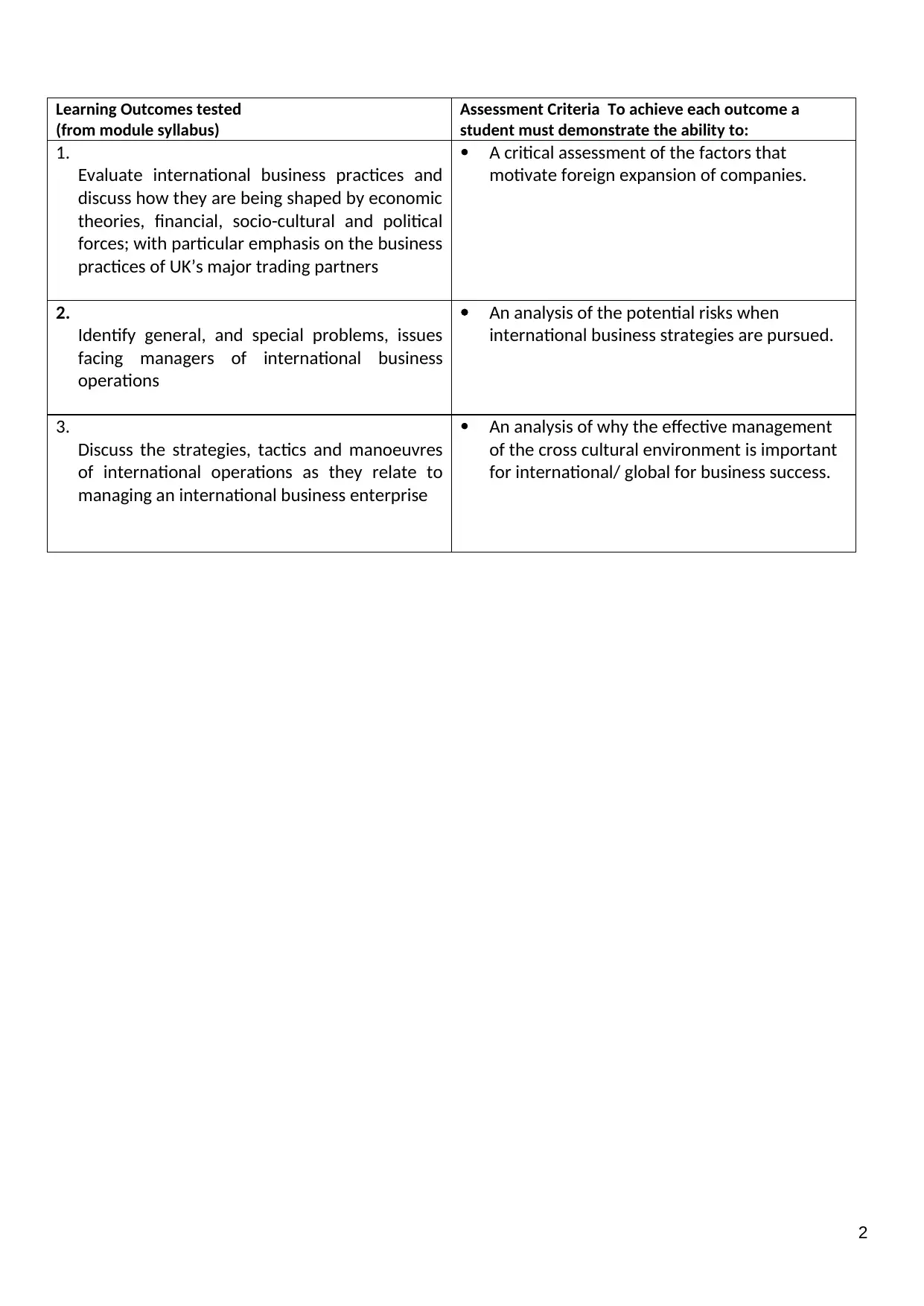
Learning Outcomes tested
(from module syllabus)
Assessment Criteria To achieve each outcome a
student must demonstrate the ability to:
1.
Evaluate international business practices and
discuss how they are being shaped by economic
theories, financial, socio-cultural and political
forces; with particular emphasis on the business
practices of UK’s major trading partners
A critical assessment of the factors that
motivate foreign expansion of companies.
2.
Identify general, and special problems, issues
facing managers of international business
operations
An analysis of the potential risks when
international business strategies are pursued.
3.
Discuss the strategies, tactics and manoeuvres
of international operations as they relate to
managing an international business enterprise
An analysis of why the effective management
of the cross cultural environment is important
for international/ global for business success.
2
(from module syllabus)
Assessment Criteria To achieve each outcome a
student must demonstrate the ability to:
1.
Evaluate international business practices and
discuss how they are being shaped by economic
theories, financial, socio-cultural and political
forces; with particular emphasis on the business
practices of UK’s major trading partners
A critical assessment of the factors that
motivate foreign expansion of companies.
2.
Identify general, and special problems, issues
facing managers of international business
operations
An analysis of the potential risks when
international business strategies are pursued.
3.
Discuss the strategies, tactics and manoeuvres
of international operations as they relate to
managing an international business enterprise
An analysis of why the effective management
of the cross cultural environment is important
for international/ global for business success.
2
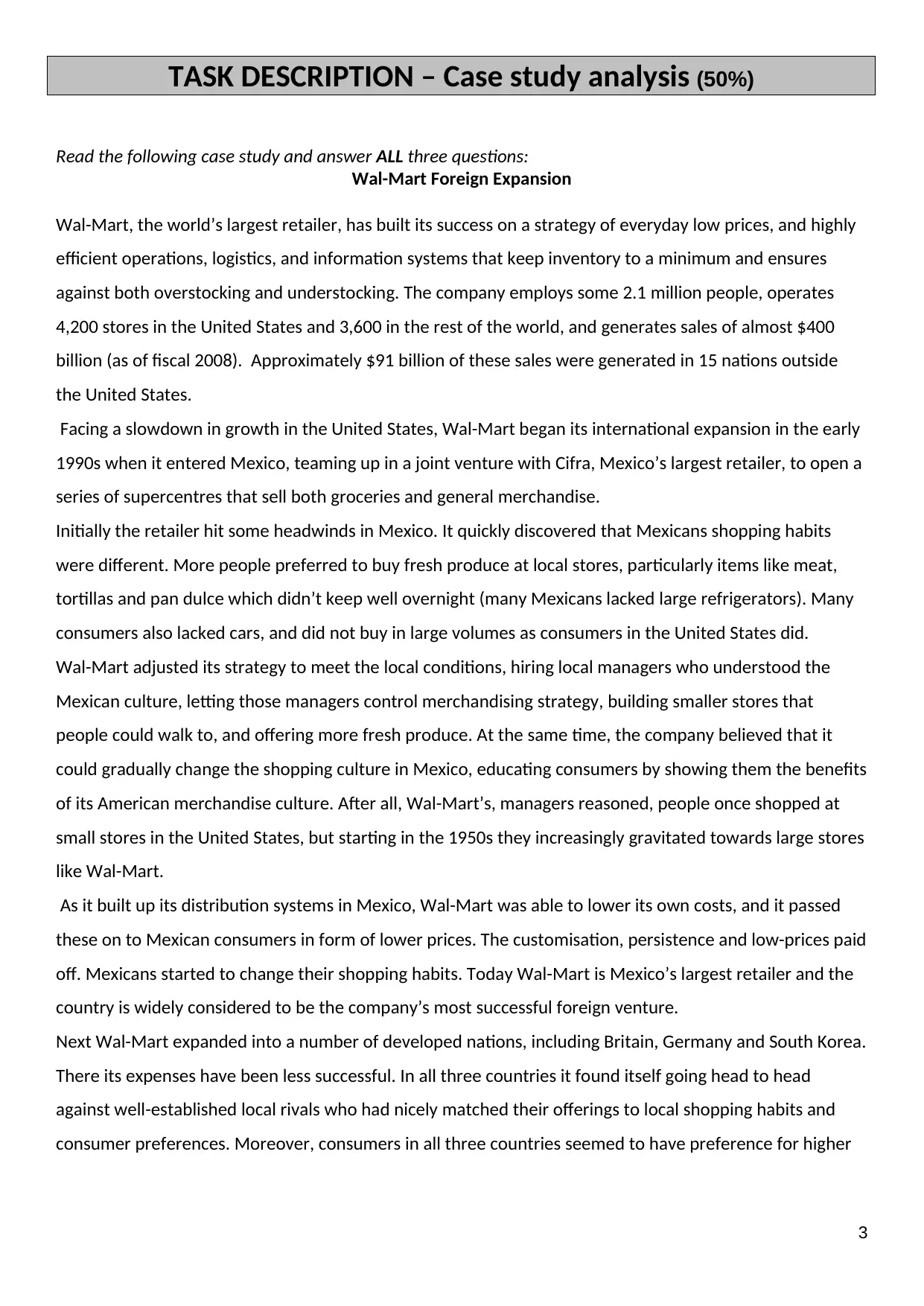
TASK DESCRIPTION – Case study analysis (50%)
Read the following case study and answer ALL three questions:
Wal-Mart Foreign Expansion
Wal-Mart, the world’s largest retailer, has built its success on a strategy of everyday low prices, and highly
efficient operations, logistics, and information systems that keep inventory to a minimum and ensures
against both overstocking and understocking. The company employs some 2.1 million people, operates
4,200 stores in the United States and 3,600 in the rest of the world, and generates sales of almost $400
billion (as of fiscal 2008). Approximately $91 billion of these sales were generated in 15 nations outside
the United States.
Facing a slowdown in growth in the United States, Wal-Mart began its international expansion in the early
1990s when it entered Mexico, teaming up in a joint venture with Cifra, Mexico’s largest retailer, to open a
series of supercentres that sell both groceries and general merchandise.
Initially the retailer hit some headwinds in Mexico. It quickly discovered that Mexicans shopping habits
were different. More people preferred to buy fresh produce at local stores, particularly items like meat,
tortillas and pan dulce which didn’t keep well overnight (many Mexicans lacked large refrigerators). Many
consumers also lacked cars, and did not buy in large volumes as consumers in the United States did.
Wal-Mart adjusted its strategy to meet the local conditions, hiring local managers who understood the
Mexican culture, letting those managers control merchandising strategy, building smaller stores that
people could walk to, and offering more fresh produce. At the same time, the company believed that it
could gradually change the shopping culture in Mexico, educating consumers by showing them the benefits
of its American merchandise culture. After all, Wal-Mart’s, managers reasoned, people once shopped at
small stores in the United States, but starting in the 1950s they increasingly gravitated towards large stores
like Wal-Mart.
As it built up its distribution systems in Mexico, Wal-Mart was able to lower its own costs, and it passed
these on to Mexican consumers in form of lower prices. The customisation, persistence and low-prices paid
off. Mexicans started to change their shopping habits. Today Wal-Mart is Mexico’s largest retailer and the
country is widely considered to be the company’s most successful foreign venture.
Next Wal-Mart expanded into a number of developed nations, including Britain, Germany and South Korea.
There its expenses have been less successful. In all three countries it found itself going head to head
against well-established local rivals who had nicely matched their offerings to local shopping habits and
consumer preferences. Moreover, consumers in all three countries seemed to have preference for higher
3
Read the following case study and answer ALL three questions:
Wal-Mart Foreign Expansion
Wal-Mart, the world’s largest retailer, has built its success on a strategy of everyday low prices, and highly
efficient operations, logistics, and information systems that keep inventory to a minimum and ensures
against both overstocking and understocking. The company employs some 2.1 million people, operates
4,200 stores in the United States and 3,600 in the rest of the world, and generates sales of almost $400
billion (as of fiscal 2008). Approximately $91 billion of these sales were generated in 15 nations outside
the United States.
Facing a slowdown in growth in the United States, Wal-Mart began its international expansion in the early
1990s when it entered Mexico, teaming up in a joint venture with Cifra, Mexico’s largest retailer, to open a
series of supercentres that sell both groceries and general merchandise.
Initially the retailer hit some headwinds in Mexico. It quickly discovered that Mexicans shopping habits
were different. More people preferred to buy fresh produce at local stores, particularly items like meat,
tortillas and pan dulce which didn’t keep well overnight (many Mexicans lacked large refrigerators). Many
consumers also lacked cars, and did not buy in large volumes as consumers in the United States did.
Wal-Mart adjusted its strategy to meet the local conditions, hiring local managers who understood the
Mexican culture, letting those managers control merchandising strategy, building smaller stores that
people could walk to, and offering more fresh produce. At the same time, the company believed that it
could gradually change the shopping culture in Mexico, educating consumers by showing them the benefits
of its American merchandise culture. After all, Wal-Mart’s, managers reasoned, people once shopped at
small stores in the United States, but starting in the 1950s they increasingly gravitated towards large stores
like Wal-Mart.
As it built up its distribution systems in Mexico, Wal-Mart was able to lower its own costs, and it passed
these on to Mexican consumers in form of lower prices. The customisation, persistence and low-prices paid
off. Mexicans started to change their shopping habits. Today Wal-Mart is Mexico’s largest retailer and the
country is widely considered to be the company’s most successful foreign venture.
Next Wal-Mart expanded into a number of developed nations, including Britain, Germany and South Korea.
There its expenses have been less successful. In all three countries it found itself going head to head
against well-established local rivals who had nicely matched their offerings to local shopping habits and
consumer preferences. Moreover, consumers in all three countries seemed to have preference for higher
3
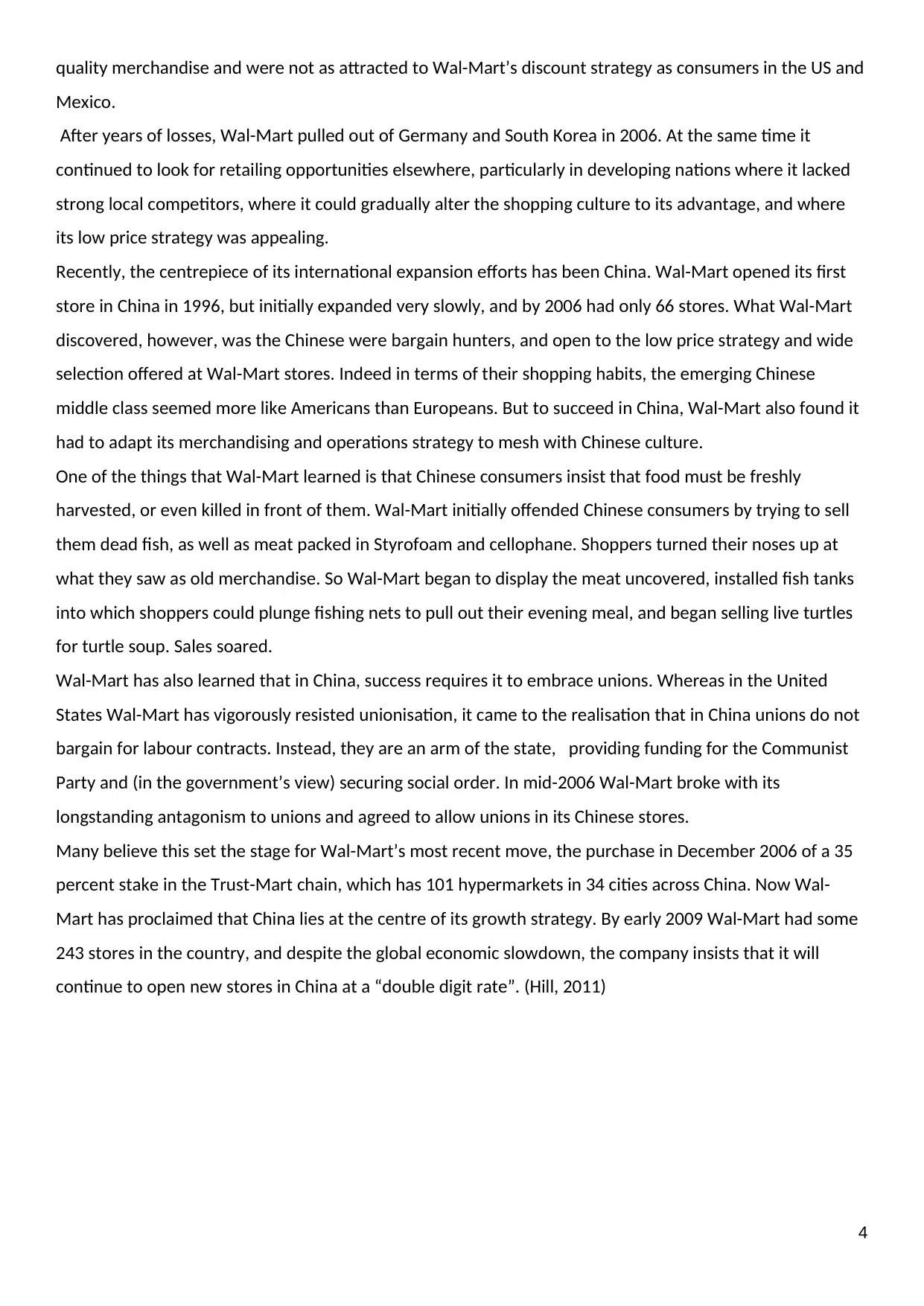
quality merchandise and were not as attracted to Wal-Mart’s discount strategy as consumers in the US and
Mexico.
After years of losses, Wal-Mart pulled out of Germany and South Korea in 2006. At the same time it
continued to look for retailing opportunities elsewhere, particularly in developing nations where it lacked
strong local competitors, where it could gradually alter the shopping culture to its advantage, and where
its low price strategy was appealing.
Recently, the centrepiece of its international expansion efforts has been China. Wal-Mart opened its first
store in China in 1996, but initially expanded very slowly, and by 2006 had only 66 stores. What Wal-Mart
discovered, however, was the Chinese were bargain hunters, and open to the low price strategy and wide
selection offered at Wal-Mart stores. Indeed in terms of their shopping habits, the emerging Chinese
middle class seemed more like Americans than Europeans. But to succeed in China, Wal-Mart also found it
had to adapt its merchandising and operations strategy to mesh with Chinese culture.
One of the things that Wal-Mart learned is that Chinese consumers insist that food must be freshly
harvested, or even killed in front of them. Wal-Mart initially offended Chinese consumers by trying to sell
them dead fish, as well as meat packed in Styrofoam and cellophane. Shoppers turned their noses up at
what they saw as old merchandise. So Wal-Mart began to display the meat uncovered, installed fish tanks
into which shoppers could plunge fishing nets to pull out their evening meal, and began selling live turtles
for turtle soup. Sales soared.
Wal-Mart has also learned that in China, success requires it to embrace unions. Whereas in the United
States Wal-Mart has vigorously resisted unionisation, it came to the realisation that in China unions do not
bargain for labour contracts. Instead, they are an arm of the state, providing funding for the Communist
Party and (in the government’s view) securing social order. In mid-2006 Wal-Mart broke with its
longstanding antagonism to unions and agreed to allow unions in its Chinese stores.
Many believe this set the stage for Wal-Mart’s most recent move, the purchase in December 2006 of a 35
percent stake in the Trust-Mart chain, which has 101 hypermarkets in 34 cities across China. Now Wal-
Mart has proclaimed that China lies at the centre of its growth strategy. By early 2009 Wal-Mart had some
243 stores in the country, and despite the global economic slowdown, the company insists that it will
continue to open new stores in China at a “double digit rate”. (Hill, 2011)
4
Mexico.
After years of losses, Wal-Mart pulled out of Germany and South Korea in 2006. At the same time it
continued to look for retailing opportunities elsewhere, particularly in developing nations where it lacked
strong local competitors, where it could gradually alter the shopping culture to its advantage, and where
its low price strategy was appealing.
Recently, the centrepiece of its international expansion efforts has been China. Wal-Mart opened its first
store in China in 1996, but initially expanded very slowly, and by 2006 had only 66 stores. What Wal-Mart
discovered, however, was the Chinese were bargain hunters, and open to the low price strategy and wide
selection offered at Wal-Mart stores. Indeed in terms of their shopping habits, the emerging Chinese
middle class seemed more like Americans than Europeans. But to succeed in China, Wal-Mart also found it
had to adapt its merchandising and operations strategy to mesh with Chinese culture.
One of the things that Wal-Mart learned is that Chinese consumers insist that food must be freshly
harvested, or even killed in front of them. Wal-Mart initially offended Chinese consumers by trying to sell
them dead fish, as well as meat packed in Styrofoam and cellophane. Shoppers turned their noses up at
what they saw as old merchandise. So Wal-Mart began to display the meat uncovered, installed fish tanks
into which shoppers could plunge fishing nets to pull out their evening meal, and began selling live turtles
for turtle soup. Sales soared.
Wal-Mart has also learned that in China, success requires it to embrace unions. Whereas in the United
States Wal-Mart has vigorously resisted unionisation, it came to the realisation that in China unions do not
bargain for labour contracts. Instead, they are an arm of the state, providing funding for the Communist
Party and (in the government’s view) securing social order. In mid-2006 Wal-Mart broke with its
longstanding antagonism to unions and agreed to allow unions in its Chinese stores.
Many believe this set the stage for Wal-Mart’s most recent move, the purchase in December 2006 of a 35
percent stake in the Trust-Mart chain, which has 101 hypermarkets in 34 cities across China. Now Wal-
Mart has proclaimed that China lies at the centre of its growth strategy. By early 2009 Wal-Mart had some
243 stores in the country, and despite the global economic slowdown, the company insists that it will
continue to open new stores in China at a “double digit rate”. (Hill, 2011)
4
Secure Best Marks with AI Grader
Need help grading? Try our AI Grader for instant feedback on your assignments.
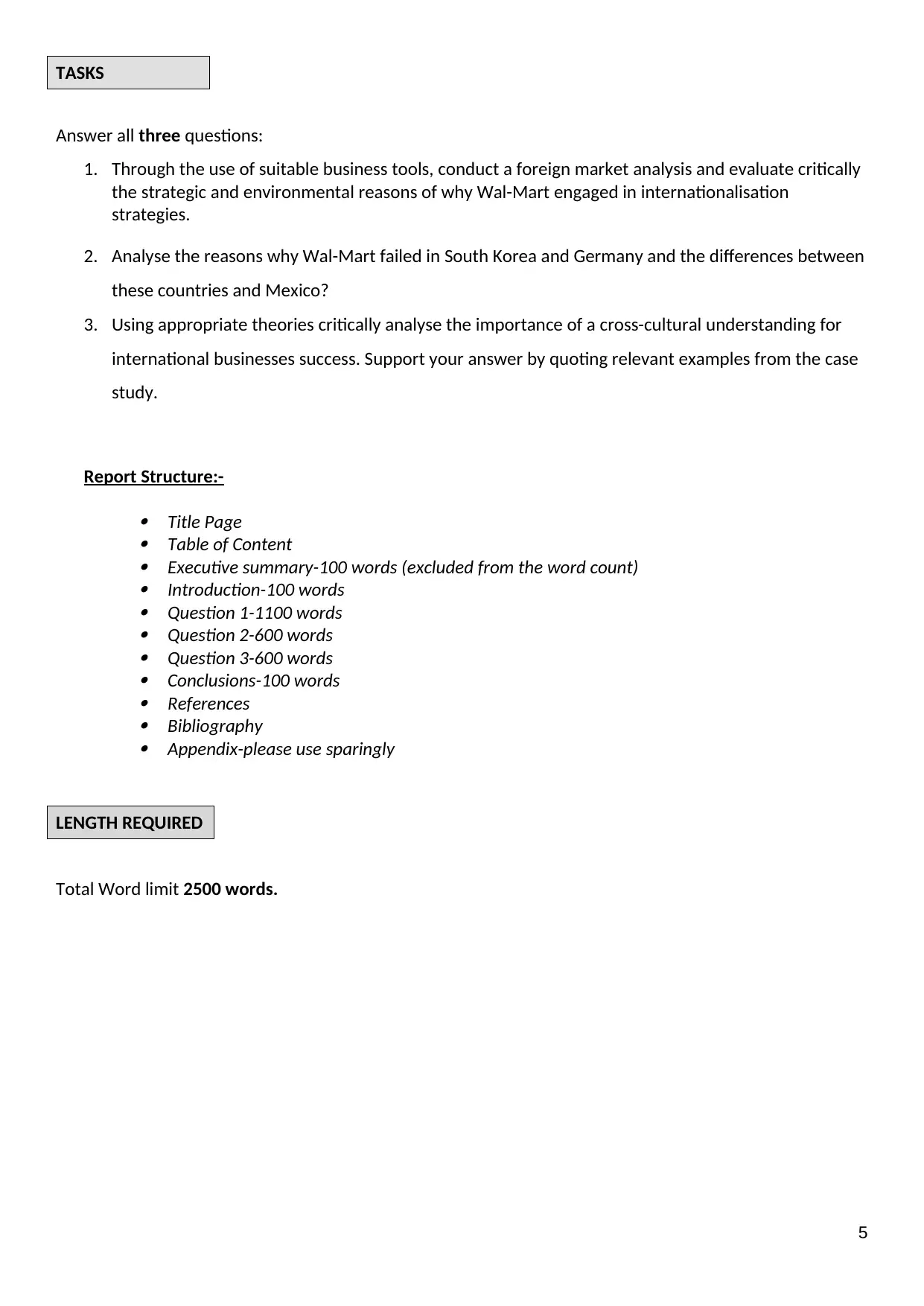
TASKS
Answer all three questions:
1. Through the use of suitable business tools, conduct a foreign market analysis and evaluate critically
the strategic and environmental reasons of why Wal-Mart engaged in internationalisation
strategies.
2. Analyse the reasons why Wal-Mart failed in South Korea and Germany and the differences between
these countries and Mexico?
3. Using appropriate theories critically analyse the importance of a cross-cultural understanding for
international businesses success. Support your answer by quoting relevant examples from the case
study.
Report Structure:- Title Page
Table of Content
Executive summary-100 words (excluded from the word count)
Introduction-100 words
Question 1-1100 words
Question 2-600 words
Question 3-600 words
Conclusions-100 words
References
Bibliography
Appendix-please use sparingly
LENGTH REQUIRED
Total Word limit 2500 words.
5
Answer all three questions:
1. Through the use of suitable business tools, conduct a foreign market analysis and evaluate critically
the strategic and environmental reasons of why Wal-Mart engaged in internationalisation
strategies.
2. Analyse the reasons why Wal-Mart failed in South Korea and Germany and the differences between
these countries and Mexico?
3. Using appropriate theories critically analyse the importance of a cross-cultural understanding for
international businesses success. Support your answer by quoting relevant examples from the case
study.
Report Structure:- Title Page
Table of Content
Executive summary-100 words (excluded from the word count)
Introduction-100 words
Question 1-1100 words
Question 2-600 words
Question 3-600 words
Conclusions-100 words
References
Bibliography
Appendix-please use sparingly
LENGTH REQUIRED
Total Word limit 2500 words.
5
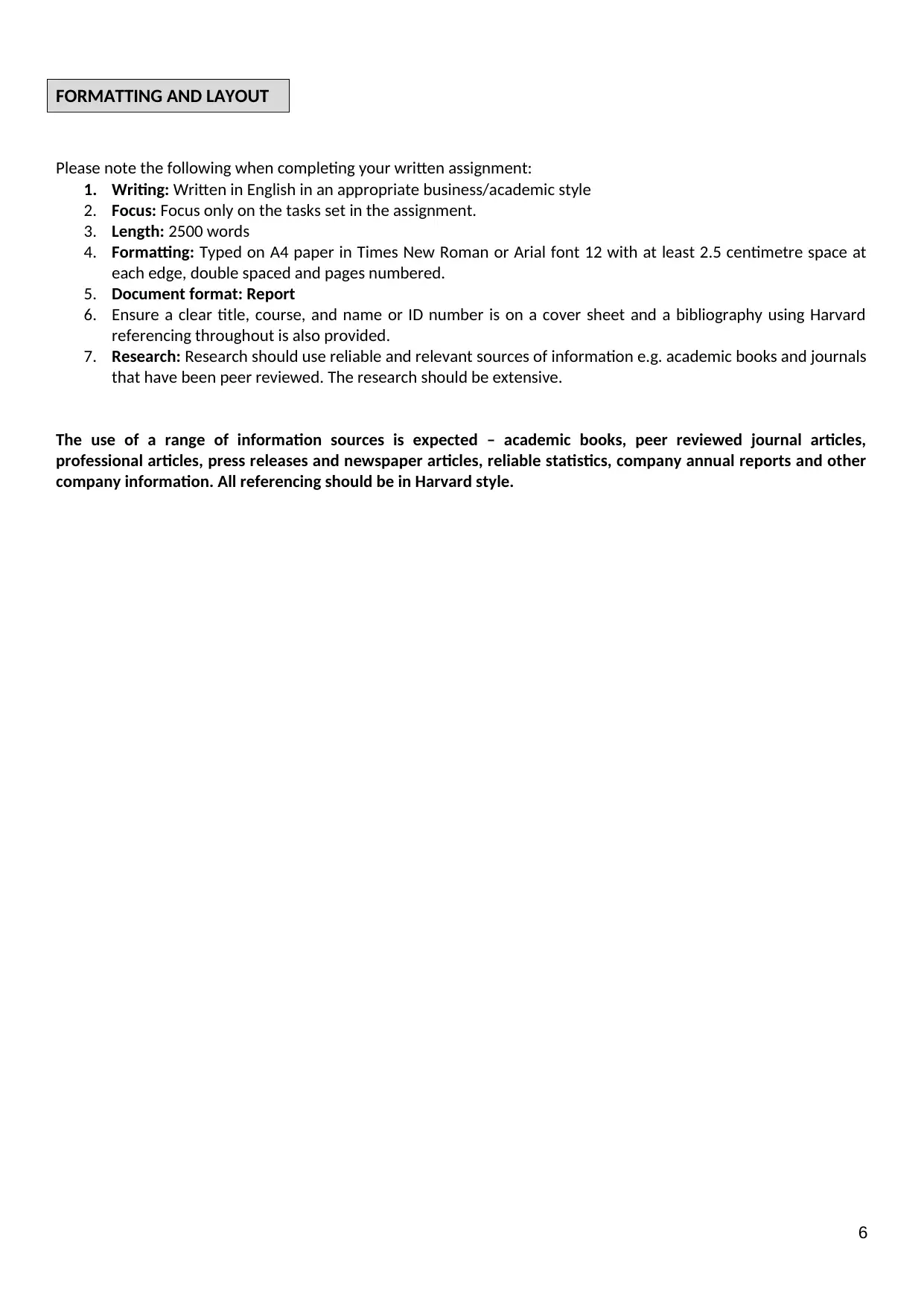
FORMATTING AND LAYOUT
Please note the following when completing your written assignment:
1. Writing: Written in English in an appropriate business/academic style
2. Focus: Focus only on the tasks set in the assignment.
3. Length: 2500 words
4. Formatting: Typed on A4 paper in Times New Roman or Arial font 12 with at least 2.5 centimetre space at
each edge, double spaced and pages numbered.
5. Document format: Report
6. Ensure a clear title, course, and name or ID number is on a cover sheet and a bibliography using Harvard
referencing throughout is also provided.
7. Research: Research should use reliable and relevant sources of information e.g. academic books and journals
that have been peer reviewed. The research should be extensive.
The use of a range of information sources is expected – academic books, peer reviewed journal articles,
professional articles, press releases and newspaper articles, reliable statistics, company annual reports and other
company information. All referencing should be in Harvard style.
6
Please note the following when completing your written assignment:
1. Writing: Written in English in an appropriate business/academic style
2. Focus: Focus only on the tasks set in the assignment.
3. Length: 2500 words
4. Formatting: Typed on A4 paper in Times New Roman or Arial font 12 with at least 2.5 centimetre space at
each edge, double spaced and pages numbered.
5. Document format: Report
6. Ensure a clear title, course, and name or ID number is on a cover sheet and a bibliography using Harvard
referencing throughout is also provided.
7. Research: Research should use reliable and relevant sources of information e.g. academic books and journals
that have been peer reviewed. The research should be extensive.
The use of a range of information sources is expected – academic books, peer reviewed journal articles,
professional articles, press releases and newspaper articles, reliable statistics, company annual reports and other
company information. All referencing should be in Harvard style.
6
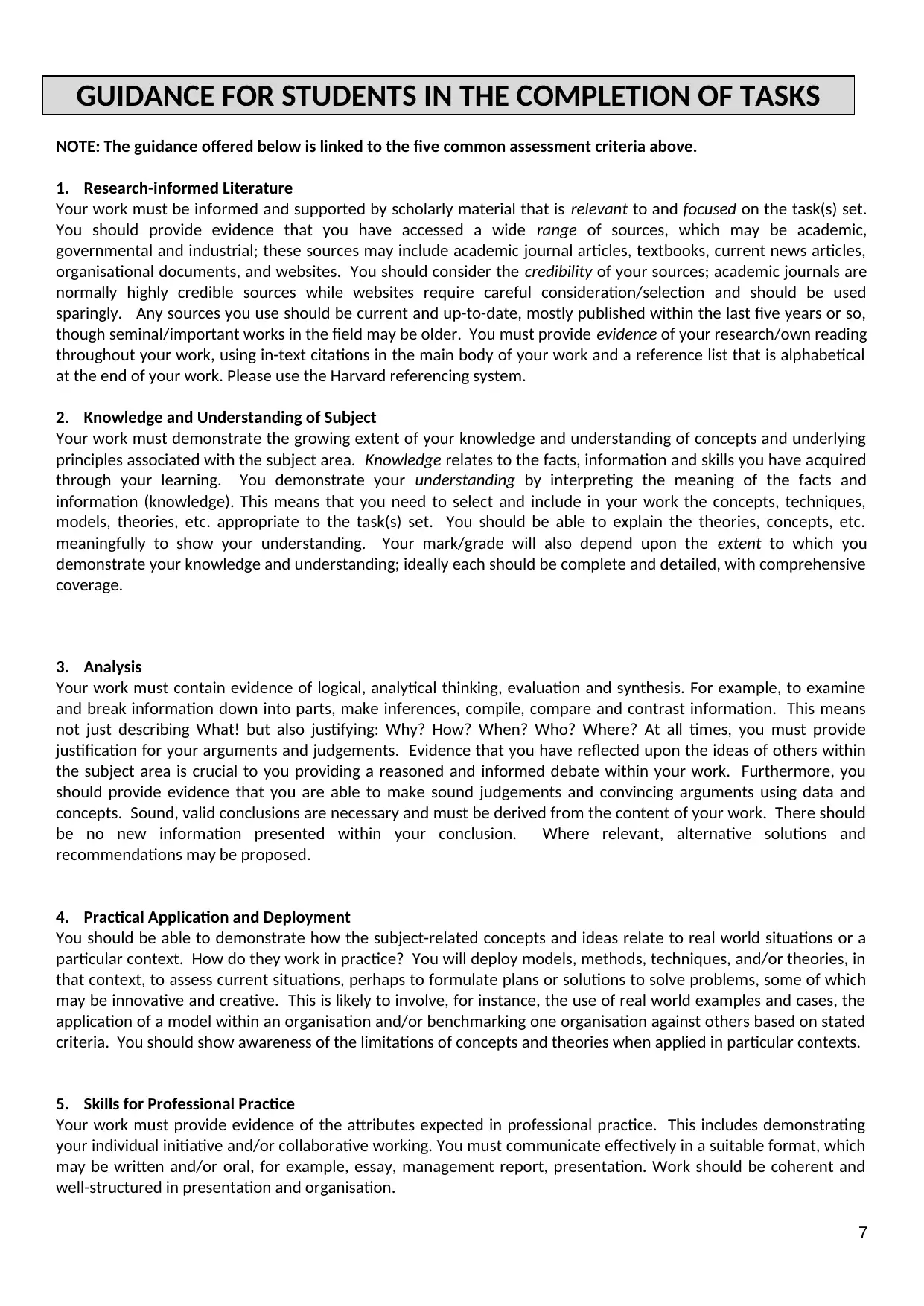
GUIDANCE FOR STUDENTS IN THE COMPLETION OF TASKS
NOTE: The guidance offered below is linked to the five common assessment criteria above.
1. Research-informed Literature
Your work must be informed and supported by scholarly material that is relevant to and focused on the task(s) set.
You should provide evidence that you have accessed a wide range of sources, which may be academic,
governmental and industrial; these sources may include academic journal articles, textbooks, current news articles,
organisational documents, and websites. You should consider the credibility of your sources; academic journals are
normally highly credible sources while websites require careful consideration/selection and should be used
sparingly. Any sources you use should be current and up-to-date, mostly published within the last five years or so,
though seminal/important works in the field may be older. You must provide evidence of your research/own reading
throughout your work, using in-text citations in the main body of your work and a reference list that is alphabetical
at the end of your work. Please use the Harvard referencing system.
2. Knowledge and Understanding of Subject
Your work must demonstrate the growing extent of your knowledge and understanding of concepts and underlying
principles associated with the subject area. Knowledge relates to the facts, information and skills you have acquired
through your learning. You demonstrate your understanding by interpreting the meaning of the facts and
information (knowledge). This means that you need to select and include in your work the concepts, techniques,
models, theories, etc. appropriate to the task(s) set. You should be able to explain the theories, concepts, etc.
meaningfully to show your understanding. Your mark/grade will also depend upon the extent to which you
demonstrate your knowledge and understanding; ideally each should be complete and detailed, with comprehensive
coverage.
3. Analysis
Your work must contain evidence of logical, analytical thinking, evaluation and synthesis. For example, to examine
and break information down into parts, make inferences, compile, compare and contrast information. This means
not just describing What! but also justifying: Why? How? When? Who? Where? At all times, you must provide
justification for your arguments and judgements. Evidence that you have reflected upon the ideas of others within
the subject area is crucial to you providing a reasoned and informed debate within your work. Furthermore, you
should provide evidence that you are able to make sound judgements and convincing arguments using data and
concepts. Sound, valid conclusions are necessary and must be derived from the content of your work. There should
be no new information presented within your conclusion. Where relevant, alternative solutions and
recommendations may be proposed.
4. Practical Application and Deployment
You should be able to demonstrate how the subject-related concepts and ideas relate to real world situations or a
particular context. How do they work in practice? You will deploy models, methods, techniques, and/or theories, in
that context, to assess current situations, perhaps to formulate plans or solutions to solve problems, some of which
may be innovative and creative. This is likely to involve, for instance, the use of real world examples and cases, the
application of a model within an organisation and/or benchmarking one organisation against others based on stated
criteria. You should show awareness of the limitations of concepts and theories when applied in particular contexts.
5. Skills for Professional Practice
Your work must provide evidence of the attributes expected in professional practice. This includes demonstrating
your individual initiative and/or collaborative working. You must communicate effectively in a suitable format, which
may be written and/or oral, for example, essay, management report, presentation. Work should be coherent and
well-structured in presentation and organisation.
7
NOTE: The guidance offered below is linked to the five common assessment criteria above.
1. Research-informed Literature
Your work must be informed and supported by scholarly material that is relevant to and focused on the task(s) set.
You should provide evidence that you have accessed a wide range of sources, which may be academic,
governmental and industrial; these sources may include academic journal articles, textbooks, current news articles,
organisational documents, and websites. You should consider the credibility of your sources; academic journals are
normally highly credible sources while websites require careful consideration/selection and should be used
sparingly. Any sources you use should be current and up-to-date, mostly published within the last five years or so,
though seminal/important works in the field may be older. You must provide evidence of your research/own reading
throughout your work, using in-text citations in the main body of your work and a reference list that is alphabetical
at the end of your work. Please use the Harvard referencing system.
2. Knowledge and Understanding of Subject
Your work must demonstrate the growing extent of your knowledge and understanding of concepts and underlying
principles associated with the subject area. Knowledge relates to the facts, information and skills you have acquired
through your learning. You demonstrate your understanding by interpreting the meaning of the facts and
information (knowledge). This means that you need to select and include in your work the concepts, techniques,
models, theories, etc. appropriate to the task(s) set. You should be able to explain the theories, concepts, etc.
meaningfully to show your understanding. Your mark/grade will also depend upon the extent to which you
demonstrate your knowledge and understanding; ideally each should be complete and detailed, with comprehensive
coverage.
3. Analysis
Your work must contain evidence of logical, analytical thinking, evaluation and synthesis. For example, to examine
and break information down into parts, make inferences, compile, compare and contrast information. This means
not just describing What! but also justifying: Why? How? When? Who? Where? At all times, you must provide
justification for your arguments and judgements. Evidence that you have reflected upon the ideas of others within
the subject area is crucial to you providing a reasoned and informed debate within your work. Furthermore, you
should provide evidence that you are able to make sound judgements and convincing arguments using data and
concepts. Sound, valid conclusions are necessary and must be derived from the content of your work. There should
be no new information presented within your conclusion. Where relevant, alternative solutions and
recommendations may be proposed.
4. Practical Application and Deployment
You should be able to demonstrate how the subject-related concepts and ideas relate to real world situations or a
particular context. How do they work in practice? You will deploy models, methods, techniques, and/or theories, in
that context, to assess current situations, perhaps to formulate plans or solutions to solve problems, some of which
may be innovative and creative. This is likely to involve, for instance, the use of real world examples and cases, the
application of a model within an organisation and/or benchmarking one organisation against others based on stated
criteria. You should show awareness of the limitations of concepts and theories when applied in particular contexts.
5. Skills for Professional Practice
Your work must provide evidence of the attributes expected in professional practice. This includes demonstrating
your individual initiative and/or collaborative working. You must communicate effectively in a suitable format, which
may be written and/or oral, for example, essay, management report, presentation. Work should be coherent and
well-structured in presentation and organisation.
7
1 out of 7
Related Documents
Your All-in-One AI-Powered Toolkit for Academic Success.
+13062052269
info@desklib.com
Available 24*7 on WhatsApp / Email
![[object Object]](/_next/static/media/star-bottom.7253800d.svg)
Unlock your academic potential
© 2024 | Zucol Services PVT LTD | All rights reserved.





